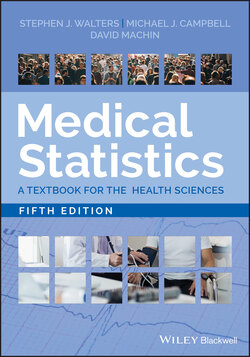Читать книгу Medical Statistics - David Machin - Страница 59
Histograms
ОглавлениеThe patterns may be revealed in large data set of a numerically continuous variable by forming a histogram with them. This is constructed by first dividing up the range of variable into several non‐overlapping and equal intervals, classes, or bins, then counting the number of observations in each. A histogram for all the baseline corn sizes in the Farndon et al. (2013) trial data is shown in Figure 2.6. In this histogram the intervals corresponded to a width of 1 mm. The area of each histogram block is proportional to the number of subjects in the particular corn size category concentration group. Thus, the total area in the histogram blocks represents the total number of patients. Relative frequency histograms allow comparison between histograms made up of different numbers of observations which may be useful when studies are compared.
Figure 2.6 Histogram of baseline index corn size (in mm) for 200 patients with corns.
(Source: data from Farndon et al. 2013).
The choice of the number and width of intervals or bins is important. Too few intervals and much important information may be smoothed out; too many intervals and the underlying shape will be obscured by a mass of confusing detail. As a rule of thumb, it is usual to choose between 5 and 15 intervals, but the correct choice will be based partly on a subjective impression of the resulting histogram. In the corn plaster trial the baseline corn size was measured in integers to the nearest mm. In Figure 2.6 we have 10 intervals or bins of width 1 mm which fits our rule of thumb. In this example an interval of 1–1.99 mm covers bin 1, 2–2.99 mm covers bin 2, etc. Histograms with bins of unequal interval length can be constructed but they are usually best avoided.
